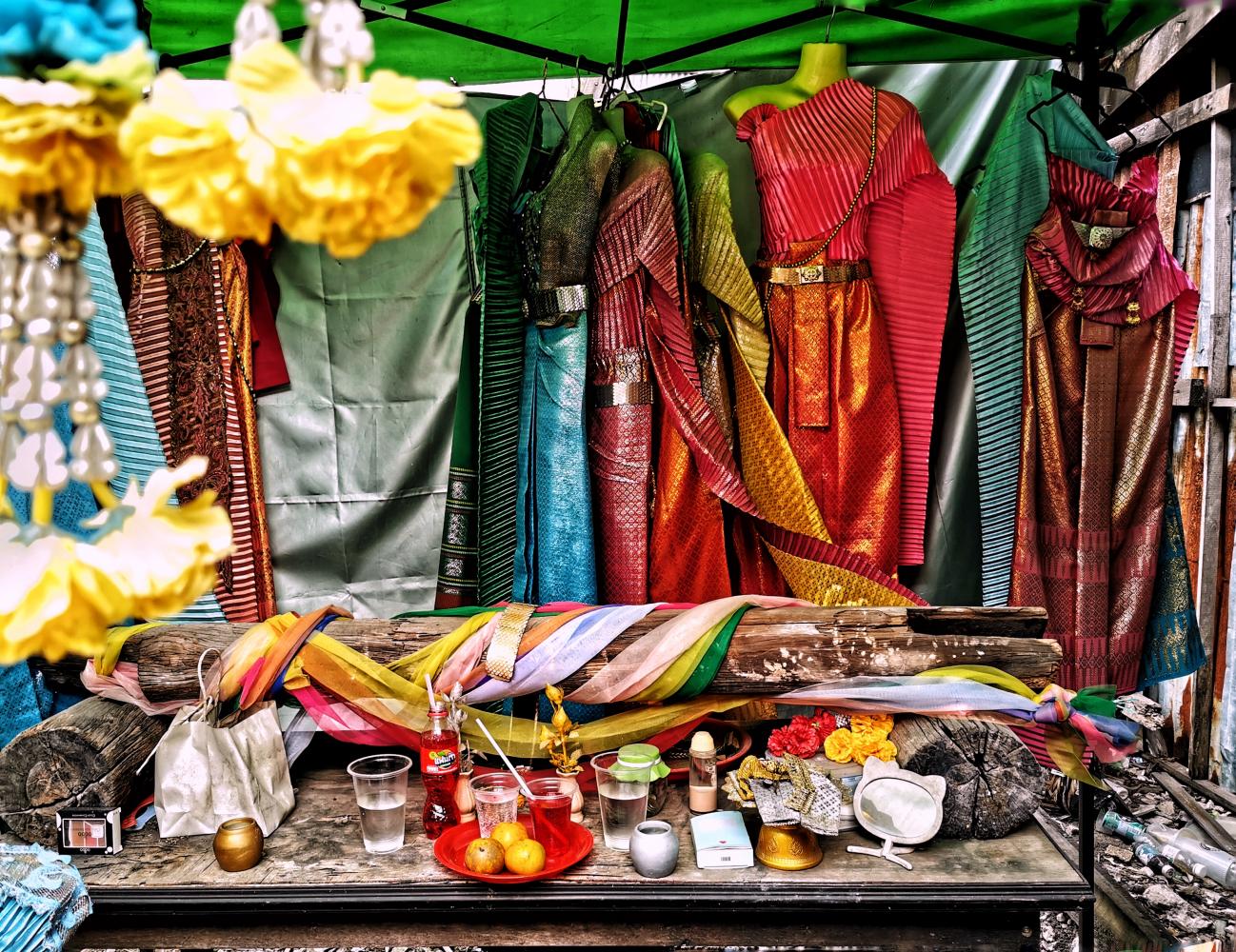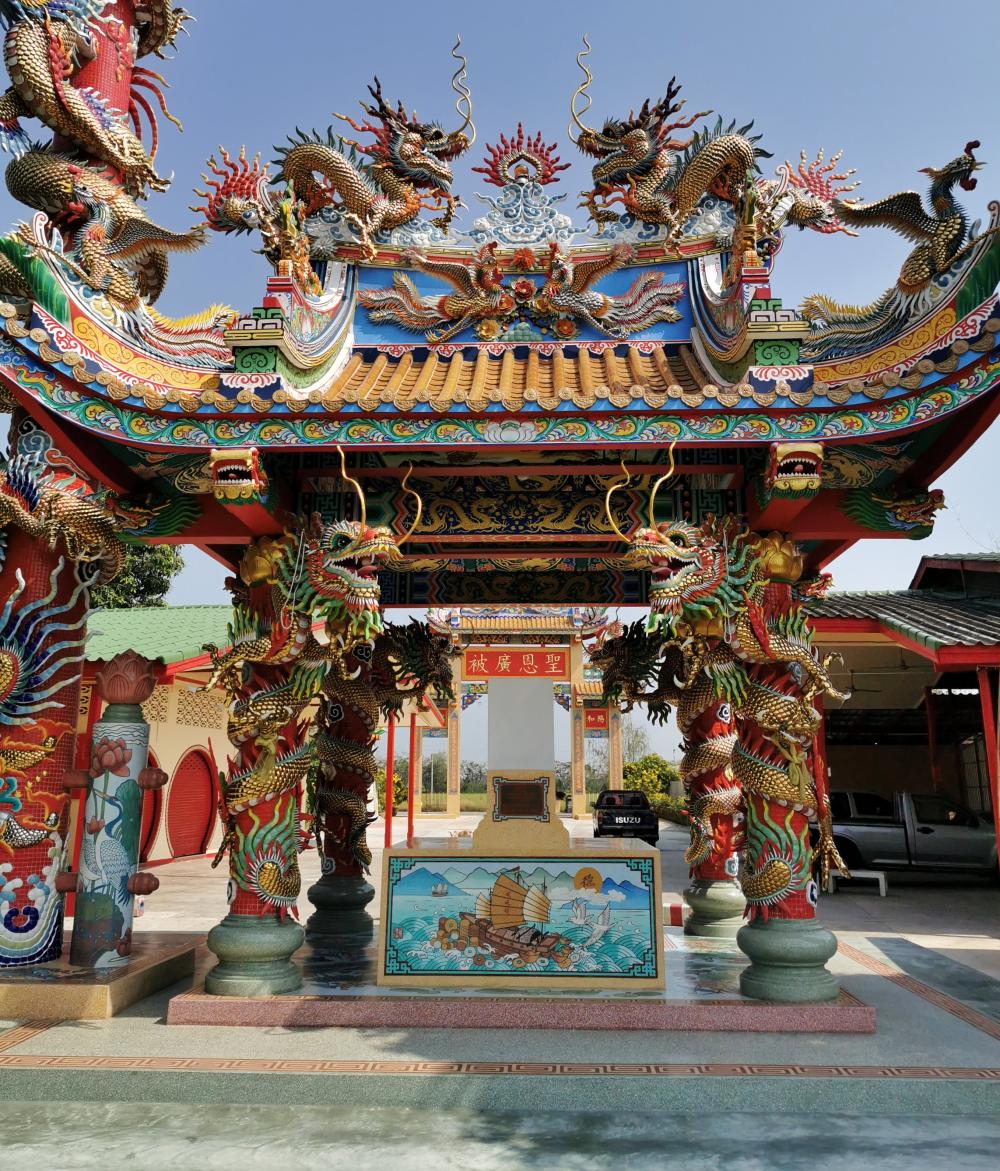'But why? There's nothing to see there. Are you looking for a filming location?" asked the old lady at the roadside food stall when she knew that after the lunch my friends and I were going to Talat Klong Sip Song Hok Wa, a nearby waterside community so named because it is located at the point where Hok Wa and Sip Song canals cross.


Tia Yong Lii is one of the very few shops in the century-old waterside community, a former commercial hub, that is still in operation. The family-run business began from a small boat roaming along the area's waterways. It settled at the present location for eight decades and is now operated by the third generation. The shop serves traditional-style coffee, such as o-yua (hot black coffee), o-liang (sweet iced black coffee), yok lo (o-liang with milk), no thao (tea mixed with coffee) and a few more, all made with robusta beans roasted and ground in the back of the shop. Every beverage is priced at only 10 baht a cup. Unlike modern coffee shops, you'll find no cake or cookies here. But there's one item every coffee shop in the old days must have and you shouldn't miss: khai luak (soft-boiled eggs served with pepper and seasoning sauce). The shop opens from 6am to 6pm. During the heydays of the community decades ago, sometimes it stayed open until midnight to accommodate its many clients.
Formerly a bustling market area, the place in Lam Luk Ka district of Pathum Thani has been a ghost town for decades. Not many people live there anymore, let alone outsiders visiting, except for film crews in need of a nostalgic location and cycling groups dropping by for refreshments at Tia Yong Lii coffee shop, one of the few businesses in Talat Klong Sip Song Hok Wa that keeps it from being completely dead.
"Nope, we just want to look around and maybe take some pictures," I replied with a smile.
Not long after leaving the food stall, we made it to the former market, which dates back to the late 19th century during the reign of King Chulalongkorn (Rama V) when Hok Wa and Sip Song canals were excavated. The two waterways were part of a grand irrigation scheme that successfully turned the vast land between the Chao Phraya and Nakhon Nayok rivers into a major area for the production of rice, one of Siam's top export products.
The irrigation project began with the digging of the 56km-long, 16m-wide, east-to-west Klong Paed Wa connecting the said rivers. The word paed means eight and wa is a traditional measurement unit equalling 2m. Eight wa is the equivalent of 16m, hence the name.
The canal was later called officially Klong Rangsit Prayurasakdi, after a young son of King Rama V whose mother was a daughter of Prince Sai Sanitvongse who was overseeing the project. Running in parallel to Klong Rangsit are two six-wa wide canals, namely Klong Hok Wa Sai Bon to the north and Klong Hok Wa Sai Lang to the south. Hok, by the way, means six.
Stretching from north to south between the two Hok Wa canals are many minor channels that bring water to the inner areas. Klong Sip Song (canal number 12) is one such waterway. Due to the rise of motorised land transportation, the point where Klong Sip Song meets Klong Hok Wa Sai Lang is no longer filled with boats and their namesake market, which used to be crowded, is now almost deserted. It is still called a market (talat) though.
We walked along the roofed road that runs through the length of the century-old community on the south bank of Klong Hok Wa. The rows of wooden shophouses flanking the road were generally in a sorry state. Many units have obviously been abandoned for years. Only a few still served as homes.
Finally, after 200m or so we finally reached Tia Yong Lii which sits by Klong Sip Song that cuts the elongated community into two zones. After finishing our coffee, we strolled across the arched wooden bridge to the other side of Klong Sip Song. The shophouse rows in this part are shorter than the west side of the bridge but the wooden structures are better maintained. We found a snooker club, a herbal medicine shop, and hardware store and another coffee shop. However, unlike Tia Yong Lii, these are not real shops. They are film sets for rent. The studios are run by two operators and both did not mind when we asked to have a look inside their properties.
I wish I could stay longer, just chilling and soaking in the atmosphere. But we had other places to visit, too.
While walking out of Talat Klong Sip Song Hok Wa, I asked one of my friends if he thought this old community would be of interest to travellers.
"It depends," he said. "For some people, even the Louvre Museum has nothing interesting to see."
TRAVEL INFO
- Klong Sip Song Hok Wa Market is located in Pathum Thani Province, near Lam Luk Ka Hospital which is located on the other side of Hok Wa Sai Lang Canal. From Bangkok’s Sai Mai area east of Don Mueang Airport, take Road 3312 eastward past the town of Lam Luk Ka and its namesake hospital, which is 16km further down the road. About 200m from the hospital, turn right onto Lam Sai Road and up the bridge that spans over Hok Wa canal. As soon as you get down the bridge turn right into the first soi and find a spot to park your car. From there you can walk to the century-old riverside community.
- In case you use Google Maps, find the direction to Tia Yong Lii, the market’s only surviving original coffee shop. Here’s its location: https://maps.app.goo.gl/F8q9nyuL3DGrT1YB7.
- You can also search for the shop’s page on Facebook.




While most of the wooden structures in Talat Klong Sip Song Hok Wa are in a state of decay, some are still in liveable condition.


Klong Sip Song and Klong Hok Wa may no longer be used for transportation but they still provide water to the remaining farmland and fish for those who know how to catch them. These photos reflect a larger picture. If only Thailand keeps its natural environment intact, a lot of people will be guaranteed free food.





At the east end of the former market are well-preserved shophouses frequented by film production teams. The owners have turned century-old wooden structures into studios for rent complete with props that makers of period movies would need. So many films, music videos, TV series and commercials have been shot here. Right on the opposite side of Hok Wa canal is a house called Ban Saen Sung. The house and these shophouses of Talat Klong Sip Song Hok Wa have made this part of Pathum Thani a well-known location among filmmakers.




Walking through the former market, you are likely to spot a few things that stir a nostalgic feeling. Bantams, sewing machines, sun-dried food, wooden folding doors, for example, were once a common part of life in the old days.

This picture is a stark reminder of how fragile this heritage site is.


Small bicycles with sidecars can be seen in front of shophouses that are still inhabited. With such vehicles, going to the nearby fresh market and back with heavy loads is easy and costs nothing.

Thais believe that sao tok namman (a wooden pillar with sap seeping out) is home to a powerful female spirit and should be respected. This makeshift shrine was made for a such a pillar from a collapsed shophouse. Judging from the traditional dresses presented as offerings by those who had their wishes granted, this log seems to have quite a few believers.


Fancy visiting hell? It's just 3km or so from the east end of Klong Sip Song Hok Wa market. In the basement of the prayer hall of Wat Phuet Udom (misspelled on Google Maps as Wat Phut Udom), you'll find a large number of statues representing dead people being tortured for the crime they did while alive. According to traditional beliefs, each misdeed entails specific punishment. Adulterers, for example, will be forced in hell to climb up and down a thorny tree for eternity. Whenever they reach the top, they would be attacked by crows that relentlessly try to peck their eyes out. On the other hand, if they try to get down to the ground, they would be mauled by vicious dogs. After a visit to Wat Phuet Udom, you might have some idea what kind of afterlife you are destined for should you somehow end up in a Thai-style underworld.



Like in many parts of Thailand, communities on this side of Pathum Thani comprise people of different faiths living in harmony. In Talat Klong Sip Song Hok Wa alone there are several Chinese families who are Christians. A short walk from the former market, you'll find a Chinese shrine. The Holy Family Church is a few minutes' drive to the west and a mosque called Mat Ya Mu Un Islam is about 5km further from Wat Phuet Udom.

Much of Lam Luk Ka and nearby districts are still farmlands. Back roads going through these agricultural areas usually do not see many cars, apart from farm vehicles and motorcycles. The roads are therefore used as training grounds for cyclists, many of whom make a stop in Talat Klong Sip Song Hok Wa for refreshing coffee at Tia Yong Lii.


